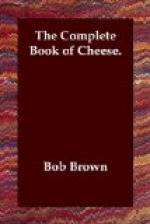Different from the many grating cheeses made from little balls of curd called grana, Caciocavallo is a pasta fileta, or drawn-curd product. Because of this it is sometimes drawn out in long thick threads and braided. It is a cheese for skilled artists to make sculptures with, sometimes horses’ heads, again bunches of grapes and other fruits, even as Provolone is shaped like apples and pears and often worked into elaborate bas-relief designs. But ordinarily the horse’s head is a plain tenpin in shape or a squat bottle with a knob on the side by which it has been tied up, two cheeses at a time, on opposite sides of a rafter, while being smoked lightly golden and rubbed with olive oil and butter to make it all the more buttery.
In Calabria and Sicily it is very popular, and although the best comes from Sorrento, there is keen competition from Abruzzi, Apulian Province and Molise. It keeps well and doesn’t spoil when shipped overseas.
In his Little Book of Cheese Osbert Burdett recommends the high, horsy strength of this smoked Cacio over tobacco smoke after dinner:
Only monsters smoke at meals, but a monster assured me that Gorgonzola best survives this malpractice. Clearly, some pungency is necessary, and confidence suggests rather Cacio which would survive anything, the monster said.
Camembert
Camembert is called “mold-matured” and all that is genuine is labeled Syndicat du Vrai Camembert. The name in full is Syndicat des Fabricants du Veritable Camembert de Normandie and we agree that this is “a most useful association for the defense of one of the best cheeses of France.” Its extremely delicate piquance cannot be matched, except perhaps by Brie.
Napoleon is said to have named it and to have kissed the waitress who first served it to him in the tiny town of Camembert. And there a statue stands today in the market place to honor Marie Harel who made the first Camembert.
Camembert is equally good on thin slices of apple, pineapple, pear, French “flute” or pumpernickel. As-with Brie and with oysters, Camembert should be eaten only in the “R” months, and of these September is the best.
Since Camembert rhymes with beware, if you can’t get the veritable don’t fall for a domestic imitation or any West German abomination such as one dressed like a valentine in a heart-shaped box and labeled “Camembert—Cheese Exquisite.” They are equally tasteless, chalky with youth, or choking with ammoniacal gas when old and decrepit.
Cheddar
The English Encyclopedia of Practical Cookery says:




